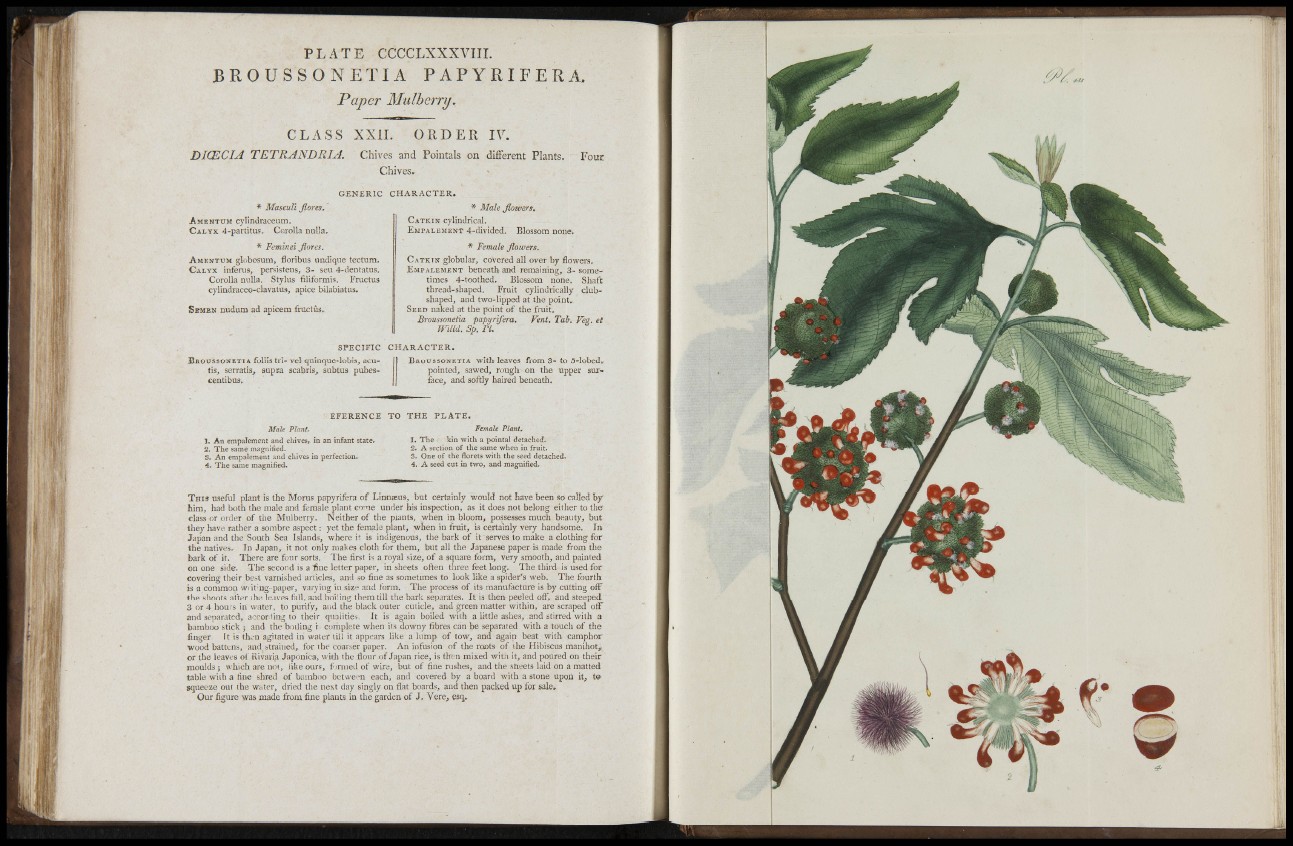
il;;'
P L A T E CCCCLXXXVTII.
B R O U S S O N E T I A PAPYRIFERA.
Taper Mulherrij.
C L A S S XXII. ORDER IV.
DICECIA TETRANDRU. Chives and Pointals on different Plants. Four
Chives.
GENERIC CHARACTER.
* Maseuli Jiores, '
AMENTUM cylindraceum.
CALYX -il-partitus. Ccjolla nulla,
* Feminei Jlorcs.
AMENTUM globosuin, floribus undique tectum.
CALYX inferus, persistens, 3- seu 4-dentatus.
Corolla nulla. Stylus tiliformis. Fructus
cylindraceo-clavatus, apice bilabiatus.
SEMEN nudum ad apicem fructus.
* Male Jlowers.
CATKIN cylindrical.
EMPALEMENT 4-divided. Blossom none.
* Female Jlowers.
C-4TKIN globular^ covered all over by flowers.
EMPALEMENT beneath and remaining, 3- sometimes
4-toothed. Blossom none. Shaft
thread-shaped. Fruit cylindricaliy clubshaped,
aud two-lipped at the point.
SEED naked at the point of the fruit.
Broussonetia papyrlfera. Vent, Tab. Veg. eC
mild. Sp. PI.
SPECIFIC CHARACTER.
BKOUSSONETIA foliis tri- vel quinque-lobis, acutiSj
serratis, supra scabris, subtus pul:)escentibus.
BKOUSSONETIA with leaves from 3- to 5-lobed,.
pointed, sawed, rough on the upper surface,
and softly haired beneath.
EFERENCE TO THE PLATE.
Male Plant.
3. An empalement and chives, in an infant state.
2. The same magnified.
3. An empalement and chives in perfection-
4. The same magnified.
Female Plant.
1. The kin "with a pointal detached.
2. A section of the same when in fruit.
3. One of the florets with the seed detached.
4. A seed cut in two, and maguiiied.
THIS useful plant is the Morus papyrifera of Linnaeus, but certainly would not have been so called by
him, had both the male and female plant co'Tie under his inspection, as it does not belong either to the
class or order of the Mulberry. Neither of the plants, when in bloom, possesses much beauty, but
they have rather a sombre aspect: yet the female plant, when in fruit, is certainly very handsome. In
Japian and the South Sea Islands, where i<" is indigenous, the bark of it serves to make a clothing for
t h e natives. In Japan, it not only makes cloth for them, but all the Japanese paper is made from the
bark of ir. There are four sorts. The first is a royal size, of a square form, very smooth, and painted
on one side. The second is a fine letter paper, in sheets often three feet long. I'he third is used for
covering their be.-.l varnished articles, and M fine as sometimes to look like a spider's web. The fourth
is a common wiit'ng-paper, varying in siz" and form. The process of its manufacture is by cutting off
t h e shoots after ibv^ leaves fall, and boiüng ihem till the bark separates. It is then peeled ofl-", and steeped
3 or 4 houis in water, to purify, and the black outer cuticle, and green matter within, are scraped off
and se!)arated, accor ling to their qualities. It is again boiled with a little ashes, and stirred with a
bamboo stick ; and the boiling i complete when ils downy fibres can be separated with a touch of the
finger It is th.-n agitated in water till it appears like a lump of tow, and again beat with camphor
wood battens, and strained, for ihe coarser paper. An infusion of the roots of ihe Hibiscus manihot,,
or the leaves o! ixivaria Japónica, with the flour of Japan rice, is then mixed with it, and poured on their
moulds ; which are noi, like ours, firmed of wire, but of fine rushes, and the stieets laid on a matted
table with a tine shred of bamboo betwe en each, and covered by a board with a stone upon it, t®
squeeze out the water, dried the next day singly on flat boards, and then packed up for sale.
Out figure was made from fine plants in the garden of J. Yere, esq.